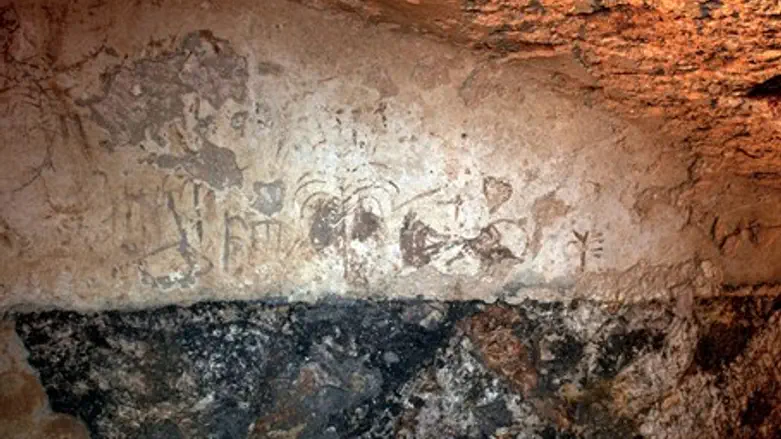
During the construction of a kindergarten at the initiative of the Jerusalem municipality in the southeastern Arnona neighborhood, an ancient mikveh (ritual bath) from the Second Temple period nearly 2,000 years ago was found - and with it extraordinary inscriptions bearing a cryptic message from the past.
Arutz Sheva got the chance to speak with officials about the exciting find.
The mikveh was found around two months ago during a routine inspection by the Israel Antiquities Authority (IAA), according to an IAA statement on Wednesday.
An anteroom, flanked by benches, led to the Jewish ritual bath, and alongside it a winepress was also excavated.
But the most unusual aspect of the mikveh was its walls, which were treated with ancient plaster and bore numerous wall paintings and inscriptions, written in mud, soot and incising.
As was customary at the end of the Second Temple period when the Romans occupied the Jewish state of Israel, the writing was in Aramaic and written in cursive Hebrew script. The symbols drawn on the wall include a boat, palm trees and various plant species, and what looks to be a menorah.
"There is no doubt that this is a very significant discovery," said Royee Greenwald and Alexander Wiegmann, excavation directors on behalf of IAA. "Such a concentration of inscriptions and symbols from the Second Temple period at one archaeological site, and in such a state of preservation, is rare and unique and most intriguing."
The inscriptions remain largely a mystery at this point, with some apparently indicating names. The drawing that might be a menorah is exceptional because in Second Temple days, Jews largely abstained from portraying the sacred object which was located in the Holy Temple.
"On the one hand the symbols can be interpreted as secular, and on the other as symbols of religious significance and deep spirituality," said excavators.
Speaking about the find, Moshe (Kinley) Tur-Paz, head of the Education Administration at the Jerusalem Municipality, said, "the unique find was discovered in a compound where two nursery schools are slated to be built and the Israel Antiquities Authority is currently carrying out the conservation process there."
"The archaeological and historical site that was exposed is of tremendous value to our identity as a Jewish people which might shine more light on the lives of our ancestors in the city of Jerusalem. We will maintain contact with the Israel Antiquities Authority and together we will examine how we can give educational and symbolic expression to the discovery that was found."
Researchers will try to unravel the relationship between the symbols and inscriptions, why they were drawn in a ritual bath, and who drew them.
They will also try to decipher the message of the symbols including the menorah, and whether they were just lighthearted graffiti or else a deeply spiritual and religious message, perhaps even a cry for help as a result of a traumatic event - such as the destruction of the Second Temple and the rebellion that was put down by the occupying Roman forces.
The wall paintings are so sensitive that air exposure damages them, and therefore the IAA started conservation measures as soon as they were found.
After initial treatment at the site, the images were removed in their entirety and transferred to the conservation laboratories of the IAA for further treatment and stabilization. In the future they will be displayed to the general public.